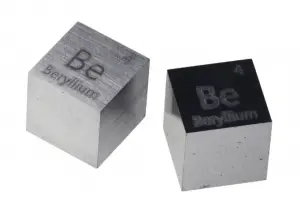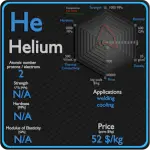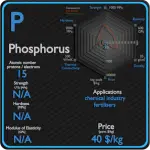This article contains comparison of key thermal and atomic properties of beryllium and nitrogen, two comparable chemical elements from the periodic table. It also contains basic descriptions and applications of both elements. Beryllium vs Nitrogen.

Beryllium and Nitrogen- About Elements


Source: www.luciteria.com
Beryllium and Nitrogen – Applications
Beryllium
Berylium can be utilized as alloying agent in production of beryllium-copper, X-ray detection diagnostics, manufacture of computer peripherals, in nuclear reactors as neutron moderators and reflectors. 80% of the beryllium used goes into copper beryllium alloys. The combination of light weight with high strength at extreme temperatures makes beryllium metal and aluminium beryllium alloys ideal for use in high performance aerospace applications such as components of rockets. Transparency to x-radiation makes pure beryllium metal essential in security equipment and high-resolution medical imaging technology, such as mammography to detect breast cancer. Copper beryllium is the hardest and strongest of any copper alloy (UTS up to 1,400 MPa), in the fully heat treated and cold worked condition. It combines high strength with non-magnetic and non-sparking qualities and it is similar in mechanical properties to many high strength alloy steels but, compared to steels, it has better corrosion resistance.
Nitrogen
Nitrogen in various chemical forms plays a major role in large number of environmental issues. The applications of nitrogen compounds are naturally extremely widely varied due to the huge size of this class: hence, only applications of pure nitrogen itself will be considered here. Two-thirds of nitrogen produced by industry is sold as the gas and the remaining one-third as the liquid. In metallurgy, nitriding is a case hardening process in which the surface nitrogen concentration of a ferrous is increased by diffusion from the surrounding environment to create case-hardened surface. Nitriding produces hard, highly wear-resistant surface (shallow case depths) of product with fair capacity for contact load, good bending fatigue strength and excellent resistance to seizure. Synthetically produced ammonia and nitrates are key industrial fertilisers, and fertiliser nitrates are key pollutants in the eutrophication of water systems. Apart from its use in fertilisers and energy-stores, nitrogen is a constituent of organic compounds as diverse as Kevlar used in high-strength fabric and cyanoacrylate used in superglue.
Beryllium and Nitrogen – Comparison in Table
| Element | Beryllium | Nitrogen |
| Density | 1.848 g/cm3 | 0.00125 g/cm3 |
| Ultimate Tensile Strength | 345 MPa | N/A |
| Yield Strength | N/A | N/A |
| Young’s Modulus of Elasticity | 287 GPa | N/A |
| Mohs Scale | 5.5 | N/A |
| Brinell Hardness | 600 MPa | N/A |
| Vickers Hardness | 1670 MPa | N/A |
| Melting Point | 1278 °C | -209.9 °C |
| Boiling Point | 2469 °C | -195.8 °C |
| Thermal Conductivity | 200 W/mK | 0.02598 W/mK |
| Thermal Expansion Coefficient | 11.3 µm/mK | — µm/mK |
| Specific Heat | 1.82 J/g K | 1.04 J/g K |
| Heat of Fusion | 12.2 kJ/mol | (N2) 0.7204 kJ/mol |
| Heat of Vaporization | 292.4 kJ/mol | (N2) 5.56 kJ/mol |











